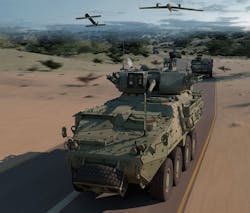Military researchers ask industry for technologies to transform the battlespace on land, sea, air, and space
ARLINGTON, Va. – U.S. military researchers are involving industry in a project to develop breakthrough technologies to generate surprise and leap-ahead military capability, while maintaining the ability to defend the U.S. against high-technologies threats.
Officials of the U.S. Defense Advanced Research Projects Agency (DARPA) in Arlington, Va., issued a solicitation last week (HR001120S0053) for the Transforming the Battlespace project, which seeks enabling technologies to transform the future of warfighting across four domains: air, ground, maritime, and space.
Today's U.S. and allied weapon systems largely are based on large, expensive, legacy platforms that are costly and time-consuming to develop, DARPA researchers say. Although they provide unmatched capability, the significant investment they represent means that they must stay in service for decades -- much longer than the evolution of enemy threats.
Today's legacy weapon systems, moreover, are difficult to update; are expensive to operate and maintain; are high-priority enemy targets; and need high levels of protection.
Related: Electronic warfare on the ground
Instead, DARPA researchers are looking to transform the battlespace with new systems based on disaggregation, increased refresh opportunities, life cycle cost savings, and use of commercial technology; DARPA wants to re-imagine battle in terms of disaggregation, diversification, dispersion, disruption, and doubt.
DARPA’s interest in Air Systems includes next-generation unmanned aerial vehicles (UAVS); hypersonic air- breathing and glide vehicles for air, ground, and sea launch; model-based systems engineering; 3D printing; propulsion; weapon for disaggregated low-cost aircraft; and machine automation.
Ground systems will involve long-range surface-to-surface precision fires for hypersonic weapons; cooperation among UAVs, and among UAVs and infantry; warfighter mobility; and fast combat robots.
Maritime systems will involve reduced use of monolithic, high-value surface ships and submarines; defenses against raids of sea-skimming high-speed missiles; defenses against advanced submarines, unmanned underwater vehicles (UUVs) and torpedoes; ways to protect U.S. waterways; arctic operations and navigation; and small, inexpensive networked vessels that use commercial artificial intelligence and autonomy.
Related: Unmanned submarines seen as key to dominating the world’s oceans
Space systems will involve reducing warfighting reliance on large, expensive, and slow-to-develop satellites and space sensors; moving space sensors from large satellites in geosynchronous orbit to small inexpensive satellites in low-Earth orbit; artificial intelligence and deep learning to collect and analyze data; operating in a contested space environment; freedom of operation in all orbits; and material science, manufacturing and computational imaging.
Submissions may include proof-of-concept prototypes, system analyses, or other work that identifies the path to a new demonstration. DARPA wants to identify promising technologies quickly, and move them to the next phase of development. DARPA recommends submitting an executive summary prior to a proposal abstract or a full proposal.
Companies interested should upload executive summaries, proposal abstracts, and full proposals to the DARPA BAA Website no later than 11 June 2021 at https://baa.darpa.mil.
Email questions or concerns to DARPA's Thomas Beutnerat [email protected]. More information is online at https://beta.sam.gov/opp/03eeb369da1c4c0ea55ff4d1baed15af/view.

John Keller | Editor-in-Chief
John Keller is the Editor-in-Chief, Military & Aerospace Electronics Magazine--provides extensive coverage and analysis of enabling electronics and optoelectronic technologies in military, space and commercial aviation applications. John has been a member of the Military & Aerospace Electronics staff since 1989 and chief editor since 1995.

